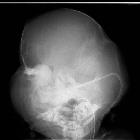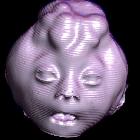Cloverleaf skull (craniosynostosis)














Cloverleaf skull, also known as kleeblattschädel syndrome or deformity, refers to a type of severe craniosynostosis which gives the skull a cloverleaf shape. It is very rare, with less than 130 case reports globally. It typically results from intrauterine premature closure of the sagittal, coronal and lambdoid sutures, through which the cranial contents bulge, giving rise to the characteristic trilobate shape (hence the name).
It is usually seen in the context of the following conditions:
- thanatophoric dysplasia: classically type II only
- severe Apert syndrome
- severe Crouzon syndrome
- Boston-type craniosynostosis
- Carpenter syndrome
- Pfeiffer-Syndrom
The vast majority of patients with kleeblattschädel have intellectual impairment and hydrocephalus.
History and etymology
Holtermüller and Wiedemann gave the name "Kleeblattschädel syndrome" in their paper published in the journal Medicinische Bild in 1958 describing severe cranial deformity. Then, the name was included in the second edition of the dictionary of clinical syndromes by Leiber in 1959.
Siehe auch:

 Assoziationen und Differentialdiagnosen zu Kleeblattschädel:
Assoziationen und Differentialdiagnosen zu Kleeblattschädel:



